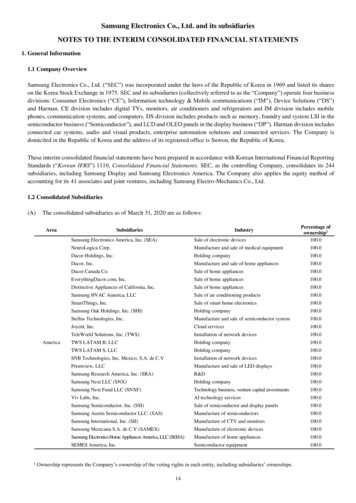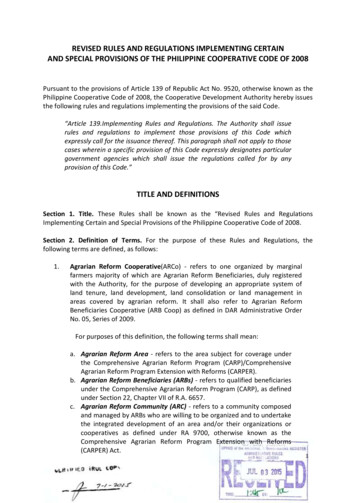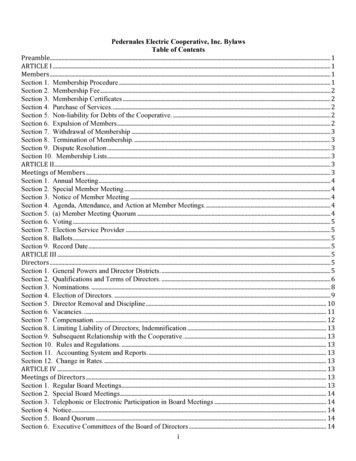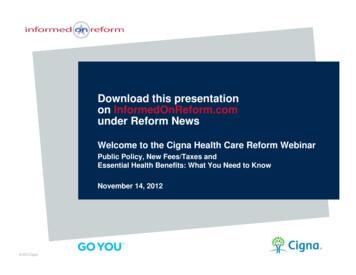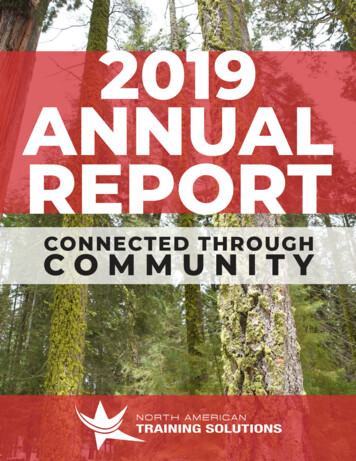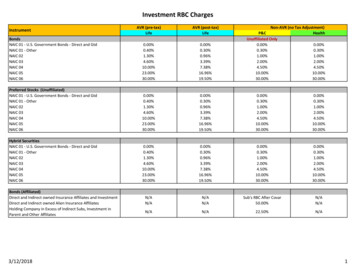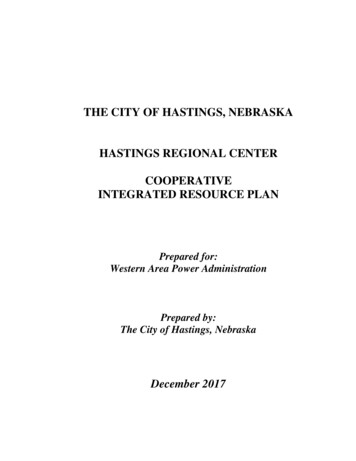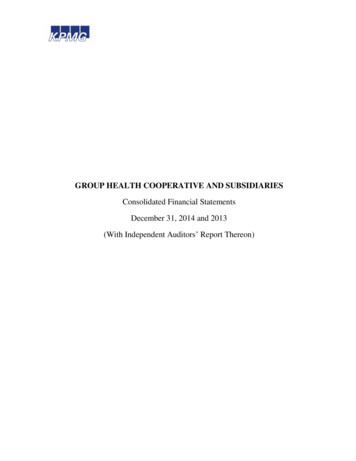
Transcription
GROUP HEALTH COOPERATIVE AND SUBSIDIARIESConsolidated Financial StatementsDecember 31, 2014 and 2013(With Independent Auditors’ Report Thereon)
GROUP HEALTH COOPERATIVE AND SUBSIDIARIESTable of ContentsPage(s)Independent Auditors’ Report1Consolidated Financial Statements:Consolidated Balance Sheets2–3Consolidated Statements of Operations and Changes in Net Assets4Consolidated Statements of Cash Flows5Notes to Consolidated Financial Statements6–47
KPMG LLPSuite 29001918 Eighth AvenueSeattle, WA 98101Independent Auditors’ ReportThe Board of TrusteesGroup Health Cooperative and Subsidiaries:Report on the Financial StatementsWe have audited the accompanying consolidated financial statements of Group Health Cooperative andsubsidiaries (the Group), which comprise the consolidated balance sheets as of December 31, 2014 and 2013,and the related consolidated statements of operations and changes in net assets, and cash flows for the yearsthen ended, and the related notes to the consolidated financial statements.Management’s Responsibility for the Financial StatementsManagement is responsible for the preparation and fair presentation of these consolidated financialstatements in accordance with U.S. generally accepted accounting principles; this includes the design,implementation, and maintenance of internal control relevant to the preparation and fair presentation ofconsolidated financial statements that are free from material misstatement, whether due to fraud or error.Auditors’ ResponsibilityOur responsibility is to express an opinion on these consolidated financial statements based on our audits.We conducted our audits in accordance with auditing standards generally accepted in the United States ofAmerica. Those standards require that we plan and perform the audit to obtain reasonable assurance aboutwhether the consolidated financial statements are free from material misstatement.An audit involves performing procedures to obtain audit evidence about the amounts and disclosures in theconsolidated financial statements. The procedures selected depend on the auditors’ judgment, including theassessment of the risks of material misstatement of the consolidated financial statements, whether due tofraud or error. In making those risk assessments, the auditor considers internal control relevant to the entity’spreparation and fair presentation of the consolidated financial statements in order to design audit proceduresthat are appropriate in the circumstances, but not for the purpose of expressing an opinion on the effectivenessof the entity’s internal control. Accordingly, we express no such opinion. An audit also includes evaluatingthe appropriateness of accounting policies used and the reasonableness of significant accounting estimatesmade by management, as well as evaluating the overall presentation of the consolidated financial statements.We believe that the audit evidence we have obtained is sufficient and appropriate to provide a basis for ouraudit opinion.OpinionIn our opinion, the consolidated financial statements referred to above present fairly in all material respects,the financial position of Group Health Cooperative and subsidiaries as of December 31, 2014 and 2013, andthe results of their operations, and their cash flows for the years then ended in accordance with U.S. generallyaccepted accounting principles.Seattle, WashingtonMarch 27, 2015KPMG LLP is a Delaware limited liability partnership,the U.S. member firm of KPMG International Cooperative(“KPMG International”), a Swiss entity.
GROUP HEALTH COOPERATIVE AND SUBSIDIARIESConsolidated Balance SheetsDecember 31, 2014 and 2013(In 09Long-term marketable securitiesLong-term investments – otherRestricted assets1,032,42458,36538,440894,67756,0188,848Land, buildings and equipment:LandBuildings and improvementsEquipmentConstruction in 858425,91260,94662,5952,003,3561,833,359Current assets:Cash and cash equivalentsShort-term marketable securitiesAccounts receivable – netInventoriesOther Total current assetsTotal land, buildings, and equipmentLess accumulated depreciationLand, buildings, and equipment – netOther assetsTotal 2
GROUP HEALTH COOPERATIVE AND SUBSIDIARIESConsolidated Balance SheetsDecember 31, 2014 and 2013(In thousands)Liabilities and Net AssetsCurrent liabilities:Accounts payableExternal delivery services payableUnearned premiums and depositsAccrued employee compensationAccrued taxes and interestCurrent portion of long-term debtCurrent portion of reserve for self-insuranceCurrent portion of retiree medical benefits Total current liabilitiesNoncurrent liabilities:Long-term debtSelf-insuranceRetiree medical benefitsPensionOtherTotal noncurrent liabilitiesTotal 99,268959,093970,3822,003,3561,833,359Commitments and contingencies (note 12)Net assets:UnrestrictedTemporarily restrictedPermanently restrictedTotal net assetsTotal See accompanying notes to consolidated financial statements.3
GROUP HEALTH COOPERATIVE AND SUBSIDIARIESConsolidated Statements of Operations and Changes in Net AssetsYears ended December 31, 2014 and 2013(In thousands)2014Revenues:PremiumsClinical services – netOther Total operating revenuesExpenses:External delivery servicesEmployee compensationGroup Health Permanente expenseMedical and operating suppliesOther expensesServices purchasedBusiness taxes and insuranceDepreciation and amortizationTotal operating expensesOperating gainNonoperating income (expense):Investment income – netInterest expenseTotal nonoperating incomeExcess of revenues over expensesChange in net unrealized investment gains and lossesChange in defined benefit pension and other postretirement plansOtherChange in unrestricted net assetsChange in temporarily restricted net assetsChange in permanently restricted net assetsChange in net assetsNet assets:Beginning of yearEnd of period See accompanying notes to consolidated financial ,289)320,949970,382649,433959,093970,382
GROUP HEALTH COOPERATIVE AND SUBSIDIARIESConsolidated Statements of Cash FlowsYears ended December 31, 2014 and 2013(In thousands)2014Cash flows from operating activities:Change in net assetsAdjustments to reconcile change in net assets to net cash provided byoperating activities:Depreciation and amortizationProvision for self-insuranceSelf-insurance claims paidRealized and change in unrealized investments gains and lossesChange in fair value of interest rate swapGain on sale of land, buildings, and equipmentEquity income of equity method investeesOtherCash provided by operating assets and liabilities:Accounts receivable – netInventoriesOther current and noncurrent assetsAccounts payableExternal delivery services payableAccrued employee compensationSelf-insuranceAccrued taxes and interestUnearned premiums and depositsPensionRetiree medical benefitsOther noncurrent liabilities 90)140,972212,24471,272 157,254212,244 3,7116,3884,1352,980Net cash provided by operating assets and liabilitiesCash flows from investing activities:Payments for land, buildings, and equipmentProceeds from disposal of land, buildings, and equipmentProceeds from sale of marketable securitiesPurchases of marketable securitiesDistribution from equity investmentsPurchases of equity investmentsRestricted assetsCollateralized securityNet cash used in investing activitiesCash flows from financing activities:Repayment of long-term debtLong-term borrowingsOtherNet cash used in financing activitiesNet (decrease) increase in cash and cash equivalentsCash and cash equivalents :Beginning of yearEnd of periodSupplemental disclosure of cash flow information:Cash paid during the year for:InterestIncome taxesSee accompanying notes to consolidated financial statements.52013
GROUP HEALTH COOPERATIVE AND SUBSIDIARIESNotes to Consolidated Financial StatementsDecember 31, 2014 and 2013(1)OrganizationThe accompanying consolidated financial statements include the accounts of Group Health Cooperative(GHC), GHC’s wholly owned subsidiary, Group Health Options, Inc. (GHO), and controlled affiliates, KPSHealth Plans (KPS), Group Health Foundation (the Foundation), and Columbia Medical Associates, LLC(CMA), (collectively, the Group).GHC is a Washington nonprofit corporation registered as a health maintenance organization headquarteredin Seattle, Washington. GHC offers comprehensive, coordinated health care to an enrolled membership fora fixed prepaid fee through its owned and leased facilities, employed providers, and contracted providers, inaddition to providing certain health care services on a fee-for-service basis to both enrollees andnonenrollees.GHO is a Washington for-profit corporation registered and operating as a health care service contractorheadquartered in Seattle, Washington. GHO provides health care coverage products that feature increasedcustomer choice, including point of service and preferred provider organization plan benefits. It is alsoregistered in Idaho as a Disability, Including Managed Care Carrier, operating in two counties.KPS is a Washington taxable nonprofit corporation registered and operating as a health care servicecontractor headquartered in Bremerton, Washington. KPS provides health care services through contractswith participating physicians and hospitals.The Foundation is a Washington nonprofit corporation. It is organized exclusively to benefit, perform thefunctions of, and carry out the purposes of GHC and other affiliated tax-exempt organizations. It supportsresearch, health careers, training, health education, GHC programs, and other projects that promote highquality health care. Grants are awarded to qualified health-related community organizations, extending theinternal resources of GHC to the community. The Foundation’s operations are largely a function of the levelof donations it receives.CMA is a Washington limited liability company headquartered in Spokane, Washington. CMA providesmedical services to families and individuals within the greater Spokane area.(2)Summary of Significant Accounting Policies(a)Principles of ConsolidationThe consolidated financial statements include those of GHC, its wholly owned subsidiaries, andcontrolled affiliates. All significant intercompany accounts and transactions have been eliminated inthese consolidated financial statements.The Group has prepared the accompanying consolidated financial statements in accordance withU.S. generally accepted accounting principles (GAAP).(b)EstimatesThe preparation of financial statements in conformity with GAAP requires management to makeestimates and assumptions that affect the amounts reported in the consolidated financial statements.Significant estimates and assumptions are used in the recording of external delivery services payable,fair value of financial instruments, allowances for uncollectible accounts, self-insurance reserves,6(Continued)
GROUP HEALTH COOPERATIVE AND SUBSIDIARIESNotes to Consolidated Financial StatementsDecember 31, 2014 and 2013pension liabilities, retiree medical liabilities, and the evaluation of contingencies and litigation.Changes in these estimates and assumptions may have a material impact on the consolidated financialstatements.(c)Cash and Cash EquivalentsCash and cash equivalents consist of liquid investments with original or remaining maturities of threemonths or less at the date of purchase and approximate fair value. Cash equivalents generally consistof money market funds.The Group is potentially subject to a concentration of credit risk related to financial instruments suchas funds held at high credit quality financial institutions, and at times, such balances with any onefinancial institution may exceed the Federal Deposit Insurance Corporation’s (FDIC) insured limits.(d)Marketable SecuritiesMarketable securities are readily convertible to cash, are carried at fair value, and are classified asavailable-for-sale securities. The Group considers securities that will mature within one year asshort-term investments. The change in unrealized gains and losses is recorded as a separate componentof the change in net assets for GHC, GHO, and KPS. The Foundation records the change in unrealizedgains and losses in investment income. The cost of debt securities is adjusted for amortization ofpremiums and accretion of discounts to maturity or, in the case of mortgage-backed securities, overthe estimated life of the security. The discount or premium is amortized using the effective-yieldmethod. Such amortization and accretion is included in investment income. Realized gains or losseson sale are calculated using the first-in, first-out (FIFO) method and are recorded in investment income.The Group’s investment transactions are recorded on a trade-date basis.(e)Repurchase AgreementsRepurchase agreements are used to obtain short-term use of funds. Under the terms of a repurchaseagreement, the transferor (borrower) transfers a security to a transferee (lender) in exchange for cashand concurrently agrees to reacquire the security at a future date. If the transferor does not surrendercontrol of the underlying security, the transaction is accounted for as a secured borrowing and reportedas a receivable by the transferee. When the transferor does surrender control, the transaction isaccounted for as a sale.The Group enters into tri-party repurchase agreements where it lends cash and receives highly liquid,high quality securities, such as U.S. Treasuries, and are accounted for as secured borrowings. TheGroup requires a minimum of 102% of the fair value of securities purchased under repurchaseagreements to be maintained as collateral and has accepted collateral that is permitted by contract orcustom to sell or repledge. The fair value of the collateral held was 23,197,000 and 0 as ofDecember 31, 2014 and 2013, respectively, of which none has been sold or repledged. The carryingamount of the repurchase agreements held as of December 31, 2014 and 2013 was 22,700,000 and 0, respectively, with remaining maturity of less than 30 days and is a component of current otherassets.7(Continued)
GROUP HEALTH COOPERATIVE AND SUBSIDIARIESNotes to Consolidated Financial StatementsDecember 31, 2014 and 2013(f)Other-than-Temporary Impairment (OTTI)An investment is impaired if the fair value of the investment is less than its book value or amortizedcost, resulting in an unrealized loss position. Impaired securities are assessed to determine if theimpairment is other-than-temporary. The Group evaluates investment securities for OTTI based onqualitative and quantitative factors. If the Group has the intent to sell, or it is more likely than not thatit will sell the security before recovery, OTTI is recorded in income equal to the entire differencebetween the security’s book or amortized cost basis and its fair value at the consolidated balance sheetdate.For debt securities, if the Group does not intend to sell or it is more likely than not it will be requiredto sell the security before recovery, OTTI is separated into the amount representing the credit loss andthe amount related to all other factors. The credit component of the OTTI is recognized in income andthe noncredit component is recognized as a component of the changes in net assets. The creditcomponent of OTTI is determined by comparing the present value of projected future cash flows withthe amortized cost basis of the fixed income security. The present value is calculated by discountingthe projected future cash flows at the effective interest rate implicit in the fixed income maturity at thedate of acquisition. For mortgage-backed and asset-backed securities, cash flow estimates are basedon assumptions regarding the underlying collateral including prepayment speeds, type of underlyingassets, geographic concentrations, default rates, recoveries, and changes in value. For all other debtsecurities, cash flow estimates are driven by assumptions regarding probability of default, includingchanges in credit ratings, and estimates regarding timing and amount of recoveries associated with adefault. Unrealized losses caused by noncredit related factors related to debt securities, for which theGroup expects to fully recover the amortized cost basis, continue to be recognized as a component ofnet assets.(g)Accounts ReceivableAccounts receivable are primarily comprised of premiums, receivables for noncovered health careservices, copays and deductibles, receivables for fee-for-service clinical services provided tononenrollees, and reinsurance. The Group records a reduction in the related premium revenues for anestimate of amounts related to retroactive enrollment changes. Provisions for contractual adjustmentsand bad debts related to clinical services revenues are recorded on the accrual basis and deducted fromgross revenues.(h)Provision for Uncollectible Accounts and RetroactivityThe Group provides an allowance for potential uncollectible accounts receivable whereby suchreceivables are reduced to their estimated net realizable value. There are various factors that can impactthe collection trends and the estimation process, such as changes in the economy, the increased burdenof copays and deductibles to be made by enrollees, and business practices related to collection efforts.The Group estimates the allowance for receivables of noncovered health care services, fee-for-serviceclinical services, and other receivables based on the aging of accounts receivable, historical collectionexperience, and other relevant factors. The allowance for uncollectible accounts was 3,086,000 and 3,451,000 at December 31, 2014 and 2013, respectively.8(Continued)
GROUP HEALTH COOPERATIVE AND SUBSIDIARIESNotes to Consolidated Financial StatementsDecember 31, 2014 and 2013The allowance for receivables of premiums is based on aging of accounts receivable and historicalexperience of enrollment retroactive changes. The allowance for retroactivity was 7,136,000 and 2,234,000 as of December 31, 2014 and 2013, respectively.(i)InventoriesInventories consist of pharmaceuticals and are stated at the lower of weighted average cost or market.(j)Long-Term Investments – OtherLong-term investments – other consists of equity and cost method investments, which includes acommingled securities trust.(k)Fair Value Measurement for Alternative InvestmentsThe Group may elect to measure alternative instruments, as defined by GAAP, using the net assetvalue (NAV) or its equivalent as a practical expedient if there is no readily determinable fair value.The election will occur at inception and on an instrument-by-instrument basis.(l)Restricted AssetsRestricted assets are assets restricted as to use pursuant to terms and conditions of the revenue bondsand bank loan agreement (note 6).The Series 2006 revenue bonds require a debt service reserve fund for the benefit of the bond owners,which shall be maintained as long as any Series 2006 bonds remain outstanding. The amount of thedebt service reserve fund is 8,848,000 for December 31, 2014 and 2013.The bank loan is secured by cash collateral maintained at all times in an amount not less than theoutstanding principal balance of the loan. The amount of the cash collateral account for December 31,2014 is 29,592,000.(m)Charitable Gift AnnuitiesAs of December 31, 2014 and 2013, the Foundation had a charitable gift annuities liability of 1,206,000 and 1,146,000, respectively, which is recorded as a component of other noncurrentliabilities in the accompanying consolidated balance sheets. Investments held for the charitable giftannuities are 1,804,000 and 2,129,000 as of December 31, 2014 and 2013, respectively, and arerecorded as a component of noncurrent other assets in the accompanying consolidated balance sheets.(n)Land, Buildings, and EquipmentLand, buildings and improvements, and equipment are recorded at cost. Depreciation is computedusing the straight-line method over the estimated useful lives of the assets or, for leaseholdimprovements, over the term of the related lease, whichever is shorter. When assets are sold or retired,their cost and related accumulated depreciation are removed from the accounts and any related gain orloss is reflected in operations. The estimated useful lives of buildings, improvements, and leaseholdimprovements are 5 to 40 years, and the estimated useful life of equipment is 2 to 20 years.9(Continued)
GROUP HEALTH COOPERATIVE AND SUBSIDIARIESNotes to Consolidated Financial StatementsDecember 31, 2014 and 2013(o)Construction in Progress (CIP)CIP projects include costs incurred while preparing assets for their intended use. CIP projects consistof major computer system installations, the construction or remodel of buildings, or the installation ofmajor equipment. The Group capitalizes interest costs on borrowings incurred during construction ordevelopment of qualifying assets. Capitalized interest is added to the cost of the underlying assetsduring construction and is depreciated or amortized over the useful lives of the assets.(p)Long-Lived AssetsIn accounting for its long-lived assets, the Group makes estimates about the expected useful lives ofthe assets, the expected residual values of the assets, and the potential for impairment based on the fairvalue of the assets and the cash flows they generate. Factors indicating potential impairment include,but are not limited to, significant decreases in the market value of the long-lived assets, a significantchange in the long-lived assets’ condition, and operating cash flow losses associated with the use ofthe long-lived assets.There is inherent risk in estimating the future cash flows used in the impairment test. If cash flows donot materialize as estimated, there is a risk the impairment charges recognized to date may beinaccurate, or further impairment charges may be necessary in the future.(q)Intangible AssetsIntangible assets are recorded at fair value and those that are subject to amortization are amortized ona straight-line basis over their estimated useful lives of 3 to 15 years. Intangible assets consist of tradename, favorable contracts and future compensation. As of December 31, 2014 and 2013, the netcarrying amount was 526,000 and 675,000, respectively, and is a component of noncurrent otherassets in the accompanying consolidated balance sheets.The Group performs an impairment review annually or when a triggering event occurs between annualimpairment tests. No impairment losses were recorded for the years ended December 31, 2014 and2013.(r)Notes ReceivableNotes receivable relate to long-term financing arrangements that exceed one year and bear interest ata market rate based on negotiated terms and are recorded at face value. Interest is recognized over thelife of the note. The Group requires collateral for notes for real estate transactions. The Group doesnot intend to sell these receivables. Amounts collected on notes receivable are included in net cashprovided by investing activities in the consolidated statements of cash flows. Notes receivable balancewas 23,166,000 and 27,679,000 at December 31, 2014 and 2013, respectively, and is a componentof noncurrent other assets. At December 31, 2014, future annual payments on notes receivable duewithin one year is 0 and due in five years or more is 23,166,000.(s)Current Other Assets and Noncurrent Other AssetsCurrent other assets and noncurrent other assets consist of interest receivable, notes receivable,deferred financing costs, interest rate swap, deposits, prepaid assets, deferred tax assets, federal taxreceivable, and repurchase agreements.10(Continued)
GROUP HEALTH COOPERATIVE AND SUBSIDIARIESNotes to Consolidated Financial StatementsDecember 31, 2014 and 2013(t)Self-InsuranceThe Group is self-insured for professional liability, industrial accident claims, and unemploymentbenefits. The Group purchases excess insurance coverage to limit its exposure for professional liabilityclaims and industrial accident claims and maintains excess insurance on a claims-made basis.Retention levels for professional liability are 10,000,000 per claim with annual aggregates of 40,000,000 in 2014 and 2013. Retention levels for industrial accident claims are 750,000, per claimand in aggregate, in 2014 and 2013. Professional liability and industrial accident claims liability aredetermined using case-based estimates for reported claims and actuarial estimates for incurred but notreported claims. These estimates are based on historical information along with certain assumptionsabout future events. Changes in assumptions related to expected claims development as well aschanges in actual experience could cause these estimates to change. At December 31, 2014 and 2013,the estimated liability for professional liability claims was 55,369,000 and 61,652,000, respectively.At December 31, 2014 and 2013, the estimated liability for industrial accident claims was 7,631,000and 7,942,000, respectively. At December 31, 2014 and 2013, the estimated liability forunemployment claims was 3,979,000 and 4,144,000, respectively. Insurance recovery receivablesfor 2014 and 2013 are 1,854,000 and 1,732,000, respectively, and are a component of noncurrentother assets. The Group is a subscriber of and purchases its professional liability excess insurancecoverage from a Risk Retention Group (RRG). As a subscriber of the RRG, the Group is also an ownergranting it rights to its subscriber’s equity in the RRG.(u)ReinsuranceThe Group limits certain exposure to claims loss by ceding reinsurance to other insurance companies.For each of its reinsurance contracts, the Group must determine if the contract providesindemnification against loss or liability related to insurance risk. Reinsurance contracts that have beendetermined to transfer risk record the premiums as revenue and claims payment as an expense. Forthose contracts that have been determined not to transfer risk, the Group records as a receivable or aliability, if applicable.Reinsurance contracts do not relieve the Group from its obligations to claimants. Failure of reinsurersto honor their obligations could result in losses to the Group.(v)DerivativesIn certain instances, the Group enters into derivative instruments to hedge specific assets and liabilities,which are carried at fair value. Prior to entering into a derivative contract designated as a hedge, therelationship between the hedging instruments and the hedged items, as well as its risk managementobjective and strategy, is formally documented. On the date the Group enters into a derivative contractutilized as a hedge, the derivative instrument is designated as either a hedge of the fair value of arecognized asset or liability of an unrecognized firm commitment (known as a fair value hedge) or ahedge of the variability in expected future cash flows associated with an existing recognized asset orliability or a forecasted transaction (known as a cash flow hedge).(w)RevenuesRevenues are derived principally from health care premiums and clinical service billings. Premiumsreceived in advance of the coverage period are deferred, and revenues are recognized in the period in11(Continued)
GROUP HEALTH COOPERATIVE AND SUBSIDIARIESNotes to Consolidated Financial StatementsDecember 31, 2014 and 2013which services are covered. Group contracts cover employee groups and are entered into withemployers or union trusts. Clinical service revenues are generated through the provision of certainmedical and pharmacy services not fully covered under existing benefit policies and from servicesprovided to nonenrollees who receive care at the Group’s facilities.GHC participates in the Medicare Advantage program and offers both Medicare Advantage (MA) andMedicare Advantage Prescription Drug (MA-PD) plans. MA plans offer Part C Medicare benefits tomembers and GHC receives capitated revenue from the Centers for Medicare and Medicaid Services(CMS), as well as supplemental premiums from the member. MA-PD plans offer Part C and Part DMedicare benefits to members and GHC receives capitated revenue from CMS, as well assupplemental premiums from the member. GHO offers MA-PD plans to its Medicare eligiblemembers.The capitated revenue from CMS for Part C and Part D is based on a risk adjustment model, where thedemographic and health status (i.e., risk score) of the member is a factor used in determining payment.The other major factors of the capitated payment are the member’s county of residence and theplan/product in which the member is enrolled. Capitated payments from CMS are received monthlyand are prospective. Adjustments for enrollment and certain member status updates are made to thepayments retrospectively. Various accruals related to Part C and Part D reven
Health Plans (KPS), Group Health Foundation (the Foundation), and Columbia Medical Associates, LLC (CMA), (collectively, the Group). GHC is a Washington nonprofit corporation registered as a health maintenance organization headquartered in Seattle, Washington. GHC offers comprehensive, coordinated health care to an enrolled membership for

